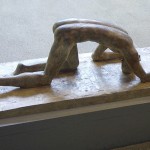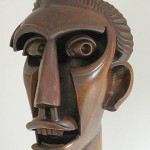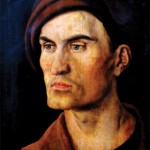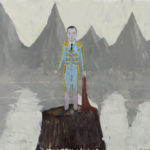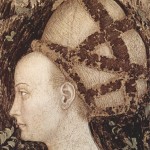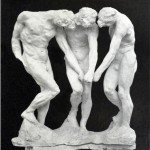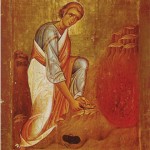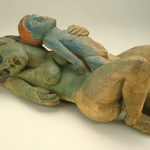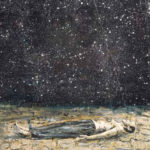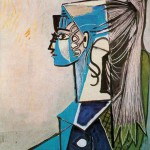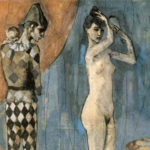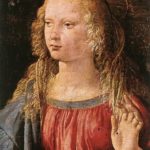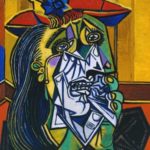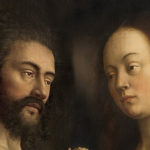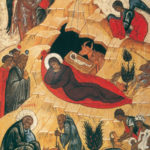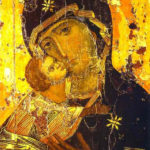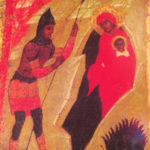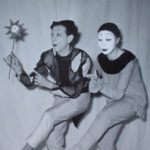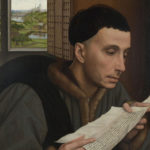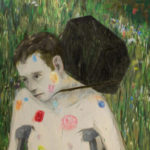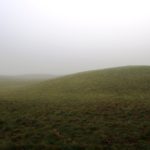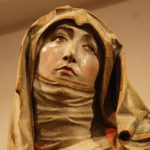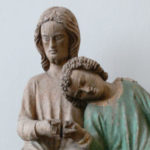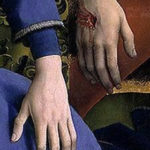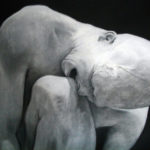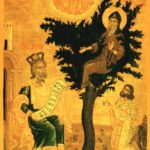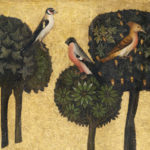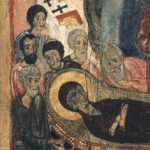Jesus and his disciples crossed the sea and when they landed came upon a man who dwelled among the tombs, so fierce he broke through the chains and fetters by which he was bound. He cut himself with stone, and no man could tame him.
“Don’t torment me!” he screamed, seeing Jesus.
“What is your name?”
“Don’t send me into the swine!”
“Tell me, what is your name?”
“Legion,” the man said, “because we are many.”
Remembering the woman with the issue of blood, Jesus gathered the power that was his and aimed it at the ferocity of Legion, ordering the spirits that tormented him into the swine nearby, a herd of about two thousand, who ran down the cliff and into the sea.
Astonished, the swineherds fled to the city and told what they had seen and when the people saw that the man they called “the maniac” was sitting and clothed and in his right mind they were afraid and begged Jesus to depart from their coasts.
But Jesus refused.
“Those are all me,” Legion said when he saw the swine bobbing in the water.
For days Jesus watched Legion haul the carcasses up the cliff, two on each shoulder, slapping the bodies down onto the grass. “They’re smart animals,” he told Jesus. “Did you have to do it that way?”
Again and again Legion climbed down the cliff and returned. He buried each in a grave, intentionally dug shallow so that the mounds could be seen all at once. “I want to see all the parts of myself,” he explained. He buried them in a grid. “Because they belong together,” he said.
And Jesus saw how violent healing could be. How easy it was to be violent. And he decided to resist violence when it came to him and to not inflict any. He vowed to never again heal a person in that way. And he repented for the violence with which he had healed Legion.
“Tell me what happened,” he said.
Legion tried to explain, but as he spoke he became agitated and could no longer sit peacefully. “Today is flaring up,” he said, “today is flaring up!”
“What do you mean?”
“I see a bloodstained toad instead of my white kitten.” He paced back and forth. “God has gone away!” Then he ran. “Love is punctured!”
Legion ran between the tombs, yelling, crashing into Jesus, running again, between the headstones and monuments, slapping his hands against them, scraping his hands on the cement, marble, stone, until they bled. His palms bloody from the stones then running away again. Dried blood on the headstones, new red blood dripping down the sides.
Sometimes he ran until nightfall while Jesus stood in the posture of orans, hands lifted to the sky, to express the immutability of what he was witnessing, that ancient gesture of prayer. Each time he returned, Jesus held Legion. He’d watched him, had not taken his eyes off him as he ran.
Not once?” Legion asked, once he calmed.
“Not once,” Jesus said, weeping.
Touching one of the scars where Legion had cut himself with a stone, Jesus saw, on the insides of each forearm, scars white from age, a lattice of fine lines intersecting like a mesh.
“Let me see all of them,” Jesus asked carefully, and, standing, Legion removed his shirt. His chest and shoulders and arms were cross-hatched with scars like threads.
“Are there more?”
Legion turned away, sure that Jesus would leave him if he saw his legs and back. But instead he heard that Jesus was very close. He heard that he was crying.
“No one has ever wept with me before.”
“Maybe the swine did,” Jesus offered.
“I would like to see all of them, if you’re willing,” he said.
So Legion took off his sandals and showed the network of scars on the soles of his feet. Then he dropped his pants. The scars were dense on his buttocks, his thighs and calves, his lower back, the web of raised white lines so thorough that Legion’s skin was barely visible, as if clothed in white lace, white socks, white gloves, white stockings, white pants. At his groin his skin was solid white, as if buried under a fall of snow.
He carefully dressed again, smoothed his hair, his beard, tipped his head to one side then the other, the pop sound of tension released, and fell silent.
Jesus could not believe how much cruelty could come to one child and again he repented for the violence with which he had healed Legion.
“I want to go with you,” Legion said on the forty-first day when all that needed to be spoken was spoken, and all that needed to be shown.
“You can’t,” Jesus answered.
“Please!” Legion implored him.
“If you follow me, you will suffer. You’ve suffered enough already.” Then he picked up his satchel and threw it over his shoulder. Tell your story to others. The bad parts and the good. It will help them. And besides, you don’t need me anymore. You have all of yourself now.”
Legion handed Jesus his sharpened stones, the edges like blades, one by one so that later when Jesus boarded the boat his pockets were heavy with them.
“Keep one,” he gave one back to Legion. “Don’t be afraid of it. It’s a sign of your victory.”
Legion slapped his chest. “Don’t overlook the body when you go about your father’s business,” he smiled. “Don’t forget about touch.” And then they hugged.
Jesus headed down the coast to where the ship was anchored and turning back, saw Legion on the top of the cliff having followed him the three miles.
In time Legion left the cemetery. He left his field of mounds and then he left Judah altogether. He went to a country where he was not known, married, and had seven sons. He continued to be called Legion because he was rich with offspring and he loved them as he wanted to have been loved by his parents, with exceeding tenderness. When he spoke of what happened to him in the field, men and women marveled.
Many times Jesus thought of Legion and their time together. When he rebuked the scribes and the Pharisees for their hypocrisy he compared them to white sepulchers and then saw again in his mind’s eye Legion running through the night, moonlight on his scars and body whiter than in the sun.
“Suffer the children to come to me,” he taught the disciples later, also remembering Legion and all he had overcome. How he had carried the parts of himself inside, alive and waiting to be joined. That those were young voices, held in his body, scared but fierce and obstinate, the chains that could not bind Legion, the fetters that he broke through. That it was those young, desperate voices who first called him “the Christ.”
When his sons had grown and married, Legion returned to the coast, to the grid of green mounds, and with the sharp stone carved his tombstone, leaving instructions with the new herdsmen to bury him in the green grid along with the swine. The tombstone read,
who was once many.
Before the Christ came.”
Amitchell125 at English Wikipedia [CC BY-SA 3.0], via Wikimedia Commons




